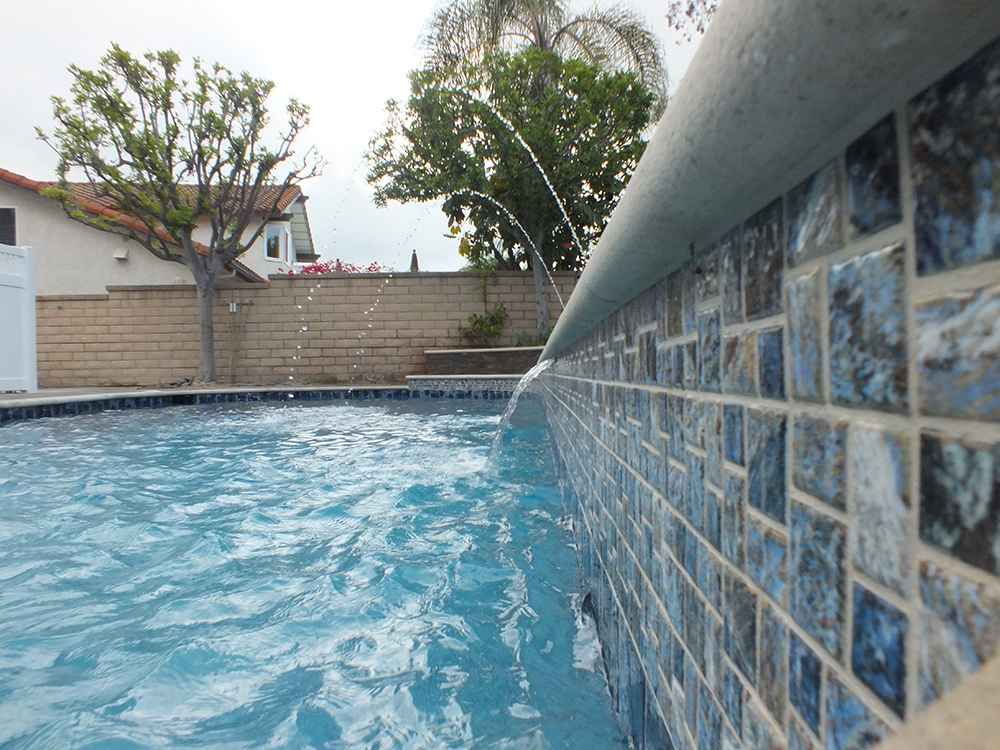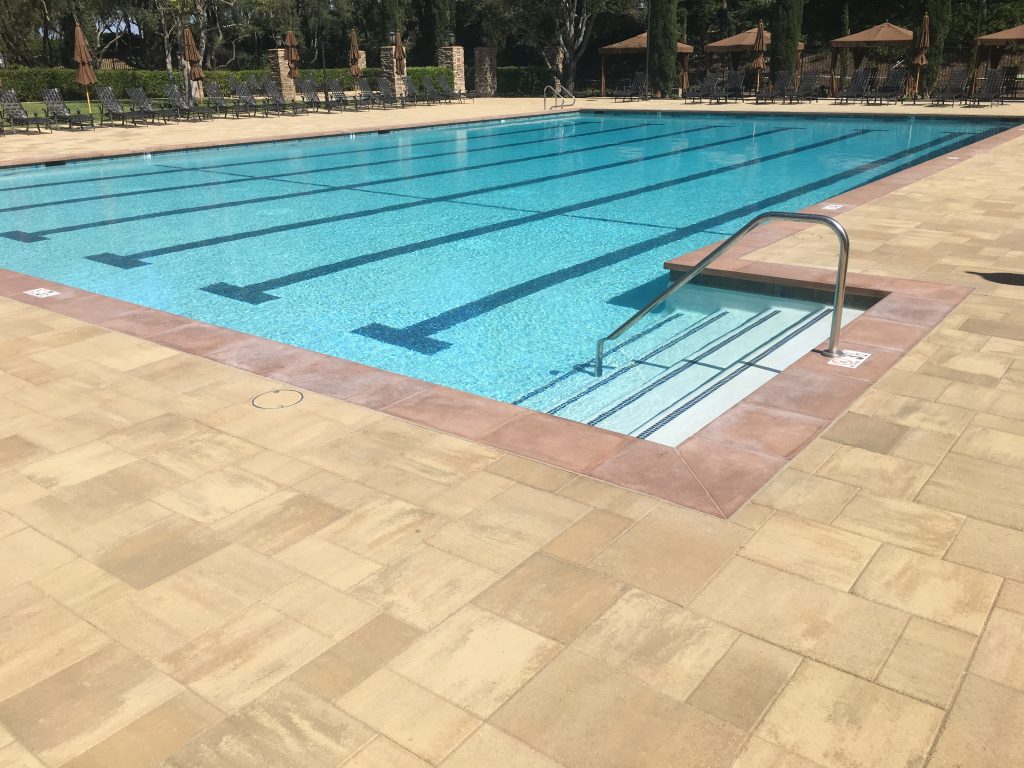Is your pool screaming to get help from a pool resurfacing service? Well first off, do you know the signs your pool is giving you? Sometimes, the signs can be a bit obvious. But other times, you have to be certain in what you’re looking for. Your pool is very helpful at showing signs when it needs help and attention. Before you call for help, learn the ten signs that you need help from a pool resurfacing service.
-
-
Plaster Flaking or Peeling
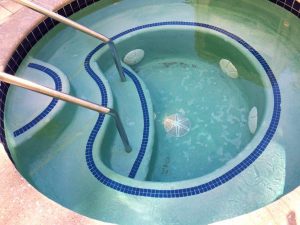
Maybe you’ve noticed the plaster is peeling along the steps or floor of your pool or spa. The pool industry refers to this as spalling. Aggressive pool water with sustained low PH or low calcium levels is the typical cause of spalling. It dissolves a soluble calcium compound called calcium hydroxide. Often, this occurs under a floating chlorinator on the top step of a pool or spa. Once this happens, there is no proper way to repair it. Usually, when this happens, it’s time to resurface or replaster. -
Surface Stains
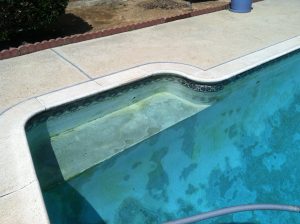
Copper, calcium, and salt are the main culprits for surface stains. These discolor the pool and turn it into a blueish gray color, or a crystal deposit. The pool industry refers to surface stains as topical stains. A topical stain will stick to the plaster surface much like dirt sticks to a windshield. You can clean a stain with an acid wash, but you must perform with caution. If the pool is severely stained, you may need to continue with a replaster for your pool surface. -
Roughness
At one time you had a fresh smooth pool plaster surface. Those days are gone as the pool chemicals have eaten away the pool surface or it has a rough calcium deposit. The kids are complaining and don’t seem as excited to go into the pool that feels like sandpaper. The last straw is when one of the little ones came out of the pool with bloody feet. Although draining your pool, acid washing and polishing can be a temporary fix. This can be nearly as costly as re-plastering and the results are inconsistent.
-
Check Cracks
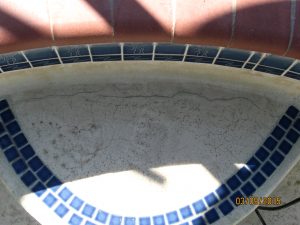
Check cracks are harder to see, but if you look close, you can notice spider web looking cracks. They can also be described as egg shell cracks or as the pros call them, craze cracks. They are a natural part of hydrating cement but become more noticeable when pools are drained and left in the sun. The cement in the plaster expands and contracts with the temperature changes and response by enlarging existing small cracks on the pool plaster surface. Unfortunately, there is no way to get rid of these cracks. The best way is to either replaster or resurface your pool to eliminate these eyesores. -
Plaster Discolorations
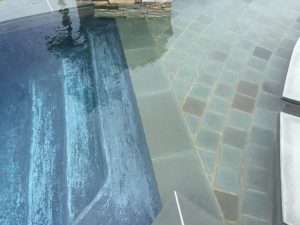
Your pool or spa may have started as a nice blue or gray colored finish, but now you can hardly notice it’s initial beautiful color. Now, your pool color looks like it may be blue with streaks and spots of white. The discoloration is because it’s being bleached out. You can usually notice it at the top steps of the pool. This is to be expected with color pool plaster finishes. There is no way to stop it or repair it once your plaster has discolored. The options are to replaster and get the same result or to install a more durable pebble finish that won’t discolor as easily. -
Structural Cracks

Maybe you have noticed you are filling your pool more often than usual. You confirmed you have a pool leak after noticing you have a crack running down the wall of your pool. There can be many things that created the crack, but the important thing to know is that the crack is underneath the plaster as well as in the plaster. Re-plastering the pool will only cover the crack, so it is important to fill in the crack with an epoxy injection and steel staples. Of course, you will have to resurface the area of repair afterward. The crack could end up becoming a problem to where leaking is involved. If the crack is severe, it may be necessary to rebuild portions of your pool. There is no way to know unless a professional inspects it and gives his opinion. You may need to call in a civil engineer or experienced pool resurfacing service. -
Rust Stains

It may have started as a small spot of rust the size of a penny on the bottom of your pool. Over time, the spot begins to grow. Now your family and friends are commenting on the large rust spot. It could be caused by rebar or a tie wire in the pool shell that is oxidizing. You can cut out and patch and cover these nuisances with pool plaster, but that repair will leave a noticeable patch on the floor or wall of the pool. Plus, if there are too many of these rust stains, then it may be necessary to resurface the entire pool. -
Loss of Pebbles
A good pebble job should last 20 plus years but if it’s acid washed too often, then the pebbles will become loose and dislodge. Also, the colored cement from between the stones can be leached white over time. Time to resurface.
-
Rebound Cracks in Steps and Benches.
Unfortunately, a poor trade practice was used for many years by gunite contractors involving the re-use of “rebound gunite”. This is the bounce back sand from the high-pressure application of guniteing a pool or spa. This bounce back sand has very little cement around it and should be discarded. Very often this material is re-used and thrown onto the steps and benches as a filler. Years later this weak “rebound” will separate from the sound gunite and form cracks along or below the edges of steps and benches. If so, it’s time to patch or resurface.
-
Paint or Fiberglass Failure
Many times pool owners choose to repair their pool surfaces with a less expensive pool paint of fiberglass overlay. These methods typically only last a few years before they delaminate or chalk up and cloud the water. The best repair method is to remove and replace them with plaster or pebble.
-
Get Help From Alan Smith Pools, a Pool Resurfacing Service
Don’t let these problems affect the look and function of your pool. If your pool is in need of help from a pool resurfacing service, contact Alan Smith Pools today! Call us now at (714) 628-9494 or schedule online for a free pool evaluation. Get the help you need with a service you can trust.
10 Signs You Need Help from a Pool Resurfacing Service | Alan Smith Pools, Orange CA
